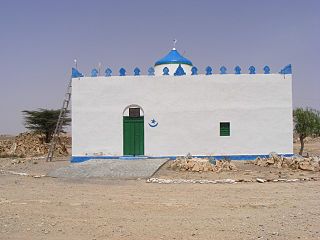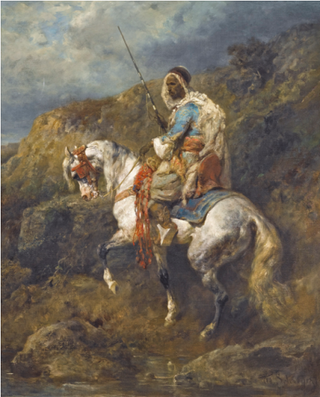
The Adal Sultanate, also known as the Adal Empire or Bar Saʿad dīn, was a medieval Sunni Muslim Empire which was located in the Horn of Africa. It was founded by Sabr ad-Din III on the Harar plateau in Adal after the fall of the Sultanate of Ifat. The kingdom flourished c. 1415 to 1577. At its height, the polity under Sultan Badlay controlled the territory stretching from Cape Guardafui in Somalia to the port city of Suakin in Sudan. The Adal Empire maintained a robust commercial and political relationship with the Ottoman Empire. Sultanate of Adal was alternatively known as the federation of Zeila.

Ahmad ibn Ibrahim al-Ghazi was the Imam of the Adal Sultanate from 1527 to 1543. Commonly named Ahmed Gragn in Amharic and Gurey in Somali, both meaning the left-handed, he led the invasion and conquest of Abyssinia from the Sultanate of Adal during the Ethiopian-Adal War. He is often referred to as the "King of Zeila" in medieval texts.
Mahfuz was a Garad, Emir of Harar and Governor of Zeila in the Adal Sultanate. Although he was originally only emir of a small region he would rise to become leader of Adal due to his popularity, wielding more power than the sultan of Adal. He is often known as the "Captain of Zeila" in medieval texts.
The Walashma dynasty was a medieval Muslim dynasty of the Horn of Africa founded in Ifat. Founded in the 13th century, it governed the Ifat and Adal Sultanates in what are present-day, Somalia, Djibouti, Eritrea and eastern Ethiopia.

The Darod is a Somali clan. The forefather of this clan is Sheikh Abdirahman bin Isma'il al-Jabarti, more commonly known as Darod. The clan primarily settles the apex of the Horn of Africa and its peripheries, the Somali hinterlands adjacent to Oromia (Ogaden), and both sides of the Kenya–Somalia border. The Darod clan is the largest Somali clan family in the Horn of Africa.
Abū Bakr ibn Muḥammad, , was a Sultan of the Adal Sultanate in the Horn of Africa. The historian Richard Pankhurst credits Abu Bakr with founding the city of Harar, which he made his military headquarters in 1520. He was of Harari background.
ʿUmar Dīn, , was a Sultan of the Adal Sultanate in the Horn of Africa. He was the younger brother of Abu Bakr ibn Muhammad. According to historian Richard Pankhurst, Umar was of Harari background.
The Battle of Shimbra Kure was fought on 9 March 1529 between the forces of Adal led by Imam Ahmad ibn Ibrahim al-Ghazi, and the Abyssinian army, under Dawit II. It was the first major battle of the Ethiopian–Adal War.
The Marehan is a Somali clan, which is part of one of the largest Somali clan families, the Darod.

The Karanle are a Somali clan, forming one of the six branches of the larger Hawiye clan. The Karanle are geographically spread out across three countries: Somalia, Ethiopia, and Kenya. Among all of the Karanle inhabited regions of the Horn of Africa, Ethiopia is the where the majority of the clan reside. In Ethiopia, the Karanle are mainly found in Harar, Hubat, and Babile but they also inhabit the Somali Region, Dire Dawa and surrounding regions. The majority of the Karanle Sub-clans predominantly reside in the regions of Ethiopia where the Somali population is predominant, with the exception of the Murusade Sub-clan, who reside in central and southern Somalia.

The Harari people are a Semitic-speaking ethnic group which inhabits the Horn of Africa. Members of this ethnic group traditionally reside in the walled city of Harar, simply called Gēy "the City" in Harari, situated in the Harari Region of eastern Ethiopia. They speak the Harari language, a member of the South Ethiopic grouping within the Semitic subfamily of the Afroasiatic languages.
Garad is a term used to refer to a king, Sultan or regional administrator. It was used primarily by Muslims in the Horn of Africa that were associated with Islamic states, most notably the Adal Sultanate.

The Jidwaq is a major subclan, part of one of the largest Somali clans families, the Absame Darod. Jidwaq are well known for their conquests in Abyssinia during the 1500s they played a very prominent role in the Adal Sultanate. They are famous for bringing the largest army and were very loyal to Imam Ahmad. Jidwaq have produced notable generals such as Ahmed Girri Bin Hussein who was the right hand man of Ahmad ibn Ibrahim al-Ghazi.

A Malassay was a member of the elite cavalry units that formed the Adal Sultanate's household troops. According to Manfred Kropp, Malassay were the Harari armed forces.
GaradAbun Ibn Adash or Abogn ibn Adish was a Harari Emir of the Adal Sultanate. He was the de facto ruler of Adal reducing the Adal sultan to nominal leader. In this period Sultan Abu Bakr ibn Muhammad would move Adal's capital to Harar city after killing emir Abogn in order to regain influence in Adal.

Hubat, also known as Hobat, or Kubat was a historical Muslim state located in present-day eastern Ethiopia. Historically part of the Adal region alongside Gidaya and Hargaya states on the Harar plateau. Hubat is today within a district known as Adare Qadima which includes Garamuelta and its surroundings in Oromia region. The area is 30 km north west of Harar city at Hubeta, according to historian George Huntingford. Trimingham locates it as the region between Harar and Jaldessa. Archaeologist Timothy Insoll considers Harla town to be Hubat the capital of the now defunct Harla Kingdom. and Karanle

The Geri Koombe is a sub-clan of Darod, a prominent Somali clan with the earliest records of Garadship. Gerikombe is one of the greatest tribes in Darod. Gerikombe kablalax darod ismacil jabarti. The Geri live in the Somali Region of Ethiopia between Tuli guled, Harar and Jigjiga, in Wardheer zone, in Bale, Bay, the Kismayo regions and in the Northern Frontier District of Kenya like Wajeer Garissa.

Ahmed Girri Bin Hussein was a Somali military commander and general that served the Adal Sultanate. He played a very prominent role in the campaigns of Ahmad ibn Ibrahim al-Ghazi by bringing one of the largest armies to aid the Imam in Jihad. Ahmed Girri hailed from the Yabarray clan. He was also the chieftain of Habr Maqdi which was a collective of Yabarray and Bartire. He was regarded one of the most capable generals during the Conquest of Abyssinia alongside Garad Matan.

The Habr Maqdi was a historical Somali confederation that composed of multiple clans such as the Bartire and Yabarre who are considered now a part of the Jidwaaq and come under the Absame Darod branch. The Habr Maqdi are well known for their conquests in Abyssinia as they had played a very prominent role in Ethiopian-Adal War. They are famous for bringing the largest army and were very loyal to Imam Ahmed. Richard Burton documented the Berteri branch of Habr Maqdi to have long been connected with the emirs of Harar. Both sub-clans of Habr Maqdi are mentioned explicitly in Futuh al-Habesh.

The Military of Adal was the core of the Adal Sultanate. The Sultanate’s Military is reported to have equipped a high level of discipline, strategic prowess and Organization, granting them successive victories in their various campaigns including the Conquest of Abyssinia. In its time in the 16th century, Adal Sultanates Military was a very powerful and an effective force.







